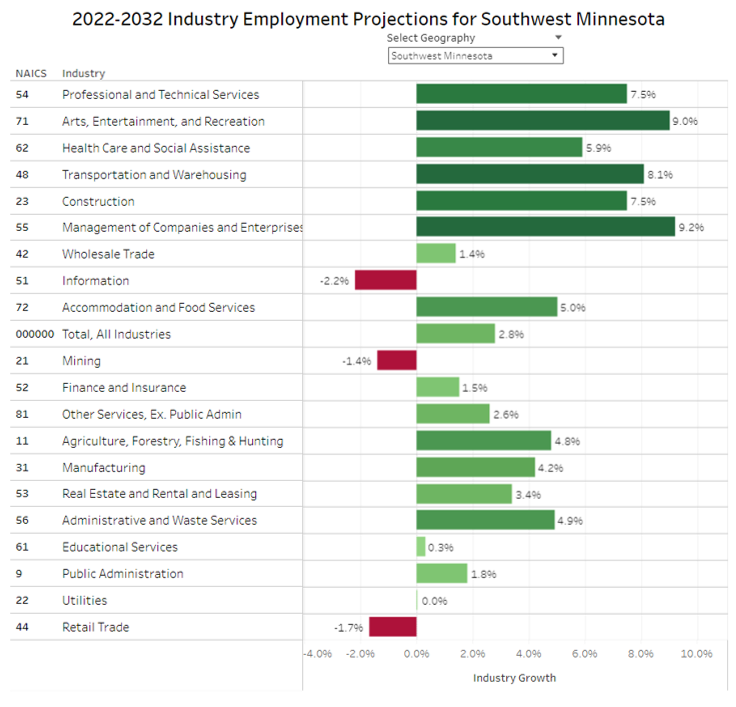 Southwest Minnesota is a national leader in agricultural production, and renewable energy.
Southwest Minnesota is a national leader in agricultural production, and renewable energy.
The region's thriving manufacturing sector includes food processing, machinery, printing, metal products, and computers and electronic products.
Want the freshest data delivered by email? Subscribe to our regional newsletters.
10/21/2024 2:50:36 PM
Luke Greiner, Amanda O'Connell
The job market in Southwest Minnesota is projected to experience moderate growth over the next decade, highlighted by substantial gains in the Health Care & Social Assistance, Manufacturing, and Transportation & Warehousing sectors. According to the Department of Employment and Economic Development's (DEED) newly released regional employment projections, Southwest Minnesota may gain more than 5,500 new jobs from 2022 - 2032, a 2.8% growth rate. While most industries are expected to expand, industries such as Information, Retail Trade and Mining are projected to see slight declines (see Figure 1).

The Health Care & Social Assistance sector is projected to add the most jobs— increasing 5.9% with 1,712 new jobs. This trend is reflective of broader trends, where the aging population and increasing demand for medical services are driving employment in Health Care.
However, this increase also presents challenges. As the demand for healthcare workers rises, there may be workforce shortages, particularly in nursing, elder care and specialized healthcare professions. Local initiatives to train and retain healthcare professionals will be crucial to meet the needs of the region.
Manufacturing is projected to add 1,345 jobs by 2032, reflecting a 4.2% increase. As a traditionally strong sector in Southwest Minnesota, Manufacturing's steady growth underscores the region's role in producing goods for both local consumption and broader markets. However, the nature of Manufacturing jobs is evolving. Automation and technology integration could reshape the workforce, requiring employees to develop new skills in areas like robotics, quality control and logistics management. Investing in upskilling and retraining workers will be important to sustain this growth.
Similarly, Transportation & Warehousing, projected to grow by 8.1% and add 513 jobs, shows the increasing importance of logistics, driven by the expansion of e-commerce and supply chain networks. The rise in goods transports necessitates more transportation workers, but the industry is facing labor shortages—particularly in truck drivers. This points to a growing need for driver recruitment and retention efforts, as well as potential investments in technology such as autonomous vehicles, which could reshape the sector in the longer term.
Accommodation & Food Services, as well as Arts, Entertainment & Recreation, are both expected to see more rapid growth, reflecting an ongoing recovery from the COVID-19 pandemic and continued demand for services in hospitality. Strong growth in Construction is also anticipated, likely driven by residential and commercial projects as well as infrastructure developments. Professional & Technical Services should also see significant growth, particularly in Architectural & Engineering Services, Management & Technical Consulting Services, and Computer Systems Design.
Conversely, the projected drop in Retail Trade employment aligns with broader national trends toward e-commerce and automation, which are reducing the demand for retail workers. Likewise, the slight decline in the Information sector may reflect automation, consolidation, or outsourcing trends in industries such as Publishing and Telecommunications.
While most sectors are projected to grow, Southwest Minnesota will face workforce challenges. The aging population means that a large portion of the workforce will be reaching the traditional retirement age in the coming years, creating gaps in critical sectors like Health Care, Manufacturing, and Transportation. Attracting young workers and retaining experienced employees will be crucial to sustaining economic growth in these areas.
As automation and technological advancements reshape industries like Health Care, Manufacturing, Transportation, and more, there will be an increasing need for upskilling and retraining programs. Ensuring that workers have the skills to adapt to these changes will be key to maintaining employment levels and fostering innovation in the region.
Contact Luke Greiner at luke.greiner@state.mn.us or Amanda O'Connell at amanda.oconnell@state.mn.us.